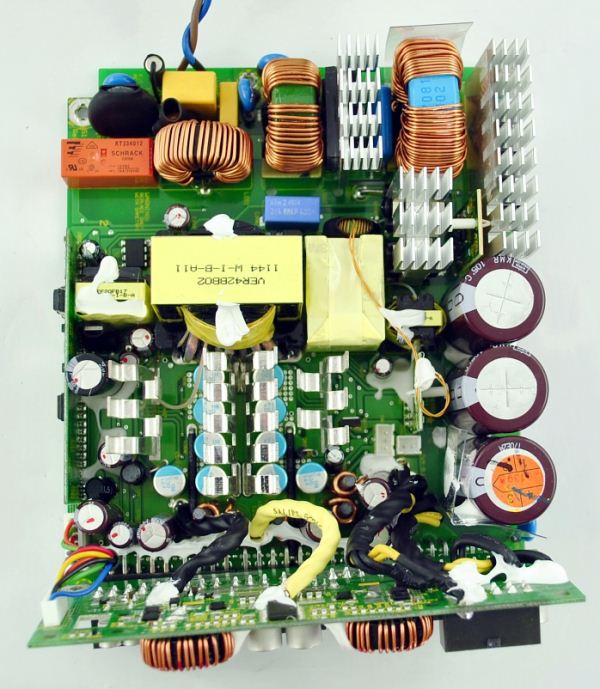XFX 1000W Pro Series 80 Plus Platinum
by Martin Kaffei on March 1, 2012 1:38 AM EST- Posted in
- Cases/Cooling/PSUs
- Seasonic
- PSUs
- XFX
- 80 Plus Platinum
Internal Design and Components
Seasonic builds this particular power supply and uses the full bridge with a resonant circuit behind. The full bridge is composed of two half bridges (one high-side and one low-side MOSFET each) which work alternately so the transformer can be driven into a balanced state. This full bridge allows them to reduce the size of the main transformer and theoretically doubles the possible output power of the half bridge converter. This only applies when identical MOSFETs are used and if all other components are chosen correctly as well. As you can see the heatsinks on the secondary side are very thin, but the MOSFETs have a low power dissipation and get cooled by the conduction path and the fan as well. Those blue capacitors beside the heatsinks are made by Nippon Chemi-Con, as are all the others in this PSU.
The EMI filtering consists of a complete mains filter with two additional X capacitors, four Y capacitors, one more common mode choke, and one differential mode choke. Moreover inrush current gets limited by a thermistor, and a MOV as passive OVP is included as well. Both rectifier bridges get their own heatsink for cooling. In the power factor pre-regulator we find three large main caps and a serperate IC for PFC control on a single sided PCB. On the fifth picture in our gallery, two MOSFETs in a large TO-247 case can be seen. Their gate connectors are equipped with a ferrite bead. Besides this the PFC diode on the left has nearly no reverse recovery time.
The resonant circuit in the middle shows one important change. Two conductions of the IC CM6901 (on a small PCB) lead to a small inductor, which is located between the resonant capacitor, the resonant coil, and the small "auxiliary coil" to relieve the main transformer. With this the current can be measured in the resonant circuit to improve regulation. A second winding is connected to the main PCB and the magnetic flux in the core passes through the regulation winding.
The buck converters for +3.3V and +5V are located on the modular PCB. With the APW7159 controller XFX is able to switch at a high frequency. With this the size of passive components can be reduced again. +12V has many short transitions to the modular board, which means resistance is somewhat lower; this helps to increase efficiency a little. The protecion IC can be found on another seperate PCB on the left. As expected XFX has a native dual output design for +12V. Soldering quality is outstanding, as is usually the case with Seasonic built PSUs. We couldn't find any dry soldered joints, though a few parts did get a bit too much solder.

















29 Comments
View All Comments
Max- - Thursday, March 1, 2012 - link
Why isn't there any mention of what the input voltage is?I assume you're testing in 120V but i'm quite sure a large percentage of your readers are coming from somewhere with a voltage more around 230V.
Please, how does this affect the efficiency? Surely there's some way you can get a power supply that can provide these tests with both 120V and 230V tests?
Omoronovo - Thursday, March 1, 2012 - link
~220v inputs generally make for more efficient PSUs, though ripple will often increase by around 16% to account for the variance of 50 vs 60hz commonly used in 220v-based countries like the UK.silverblue - Thursday, March 1, 2012 - link
230v. :)ahar - Thursday, March 1, 2012 - link
-6% to +10%connor4312 - Thursday, March 1, 2012 - link
You can see in the picture on the second page that a European plug is included, so I assume it supports 230/220V.entity279 - Thursday, March 1, 2012 - link
"for the difference ($17 USD) customers get a better fan and a few extras such as cable ties and a bag for the unused cables"The fan difference my be important important. Also, and it's not mentioned in the review, Seasonic offers 7(!!) years waranty versus XFX's 5.
Martin Kaffei - Thursday, March 1, 2012 - link
You're right.Warranty has been added..
mattgmann - Thursday, March 1, 2012 - link
The last high end PSU I've bought was an Antec Signature 850W a few years back. I believe it cost nearly $300, and there was NOTHING on the market that approached its quality at the time.It's nice to see there are a lot of new units coming out that are giving great power quality with even higher efficiency at much lower prices.
Hopefully the quality/pricing continues to trickle down to <500W power supplies.
ShieTar - Thursday, March 1, 2012 - link
"option to have the CPU run passively has <40% load is a nice feature if you don't need the airflow a PSU can provide"Having a CPU run passively (without external power) would be nice indeed ;-)
dqniel - Thursday, March 1, 2012 - link
This makes it sound like 80% is the minimum efficiency for the Platinum certification.This PSU only makes Platinum certification with 0.56% room to spare at 20% load, so I'd hardly say it "easily" makes it. Not that it matters, because the efficiency is still astounding.
80 Plus Platinum requirements at 115v:
20% load - 90% efficiency
50% load - 92% efficiency
100% load - 89% efficiency